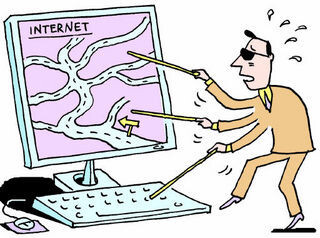hankyoreh
Links to other country sites 다른 나라 사이트 링크
Internet far from being user-friendly for disabled

Yun Seong-tae, a 41-year-old visually impaired college student, must press the "Tab" key on his computer about 30 times in order to move his cursor to the correct spot to enter a certain Web site. To surf another site, the number of times Yun has to press "Tab" reaches 27. In between each click, he must listen to the computer aurally interpret where the cursor has landed.
This is the wall Yun faces each time he wants to enter a Web site. Because he cannot see the menus on his computer screen, he cannot use the point-and-click mouse action to which most computer users are accustomed. Instead, he must use the "Tab" key to toggle through all the menus, pausing to listen to his ‘screen reader’ device explaining what each menu is. As he gets more familiar with a Web site, Yun memorizes the number of times he must press "Tab" to get to the login menu.
For visually disabled persons like Yun, surfing the Internet is a challenge of patience and time. In addition, most Web sites are not formatted for use with the ‘screen reader’ device. If Web site architects and administrators paid just a little more attention to the diversity of their users, it would make accessing the Internet a great deal easier for the disabled.
The screen reader device describes the menu’s appearance or function after reading a string of computer language script, known as "alt + explanations," which is then ’translated’ into Korean by the device. In addition, a shortcut key function is useful for the visually impaired, as well. If the shortcut key function is able to be saved on the main menu of a Web site, this cuts down considerably the amount of time needed to use a Web site, as the user can just return to bookmarked parts of the screen rather than having to toggle through and listen to explanations at every step.
"If two things - an aural explanation link and a shortcut key - are correctly in place, the visually impaired would be able to gain access to more than 90 percent of Web sites," Yun said.
To a certain extent, the government is trying to improve Web accessibility, with an aim to allow everyone to easily access the Internet. A year ago, the Ministry of Information and Communication designated 13 items needed to raise Web accessibility, including picture explanation functions and a shortcut key for the visually disabled, as well as captioning for the aurally impaired.
In October this year, the ministry surveyed the accessibility of the Web sites of 79 government organizations. This year, the average grade was 81.8, up 13.3 percent from a year ago. However, the Office of Coordination for Government Affairs (66.8), the Ministry of Patriots and Veterans Affairs (68.4) and the Gyeonggi Provincial Government (66.3) were found to have much lower than average Web accessibility for the visually impaired.
Lee Sang-hak, an official at the Ministry of Information and Communication, said that "instead of creating Web sites especially for the disabled - sites which then might suffer from a lack of information and data - it’s more efficient to fix regular Web sites. The real problem occurs in using Internet sites for shopping, transportation, news, and Internet portals, those frequented by all Web users, including the disabled," he said.
Please direct questions or comments to [englishhani@hani.co.kr]
Editorial・opinion
![[Column] Park Geun-hye déjà vu in Yoon Suk-yeol [Column] Park Geun-hye déjà vu in Yoon Suk-yeol](https://flexible.img.hani.co.kr/flexible/normal/500/300/imgdb/original/2024/0424/651713945113788.jpg) [Column] Park Geun-hye déjà vu in Yoon Suk-yeol
[Column] Park Geun-hye déjà vu in Yoon Suk-yeol![[Editorial] New weight of N. Korea’s nuclear threats makes dialogue all the more urgent [Editorial] New weight of N. Korea’s nuclear threats makes dialogue all the more urgent](https://flexible.img.hani.co.kr/flexible/normal/500/300/imgdb/original/2024/0424/7317139454662664.jpg) [Editorial] New weight of N. Korea’s nuclear threats makes dialogue all the more urgent
[Editorial] New weight of N. Korea’s nuclear threats makes dialogue all the more urgent- [Guest essay] The real reason Korea’s new right wants to dub Rhee a founding father
- [Column] ‘Choson’: Is it time we start referring to N. Korea in its own terms?
- [Editorial] Japan’s rewriting of history with Korea has gone too far
- [Column] The president’s questionable capacity for dialogue
- [Column] Are chaebol firms just pizza pies for families to divvy up as they please?
- [Column] Has Korea, too, crossed the Rubicon on China?
- [Correspondent’s column] In Japan’s alliance with US, echoes of its past alliances with UK
- [Editorial] Does Yoon think the Korean public is wrong?
Most viewed articles
- 1[Column] Park Geun-hye déjà vu in Yoon Suk-yeol
- 2Will NewJeans end up collateral damage in internal feud at K-pop juggernaut Hybe?
- 3Why Korea shouldn’t welcome Japan’s newly beefed up defense cooperation with US
- 4N. Korean hackers breached 10 defense contractors in South for months, police say
- 5[Guest essay] The real reason Korea’s new right wants to dub Rhee a founding father
- 6Thursday to mark start of resignations by senior doctors amid standoff with government
- 7[Editorial] New weight of N. Korea’s nuclear threats makes dialogue all the more urgent
- 8[Column] ‘Choson’: Is it time we start referring to N. Korea in its own terms?
- 9Kim Jong-un expressed ‘satisfaction’ with nuclear counterstrike drill directed at South
- 10The dream K-drama boyfriend stealing hearts and screens in Japan